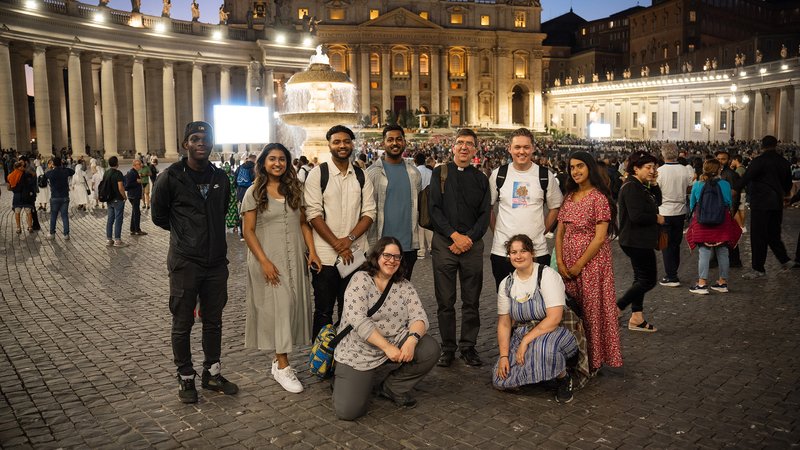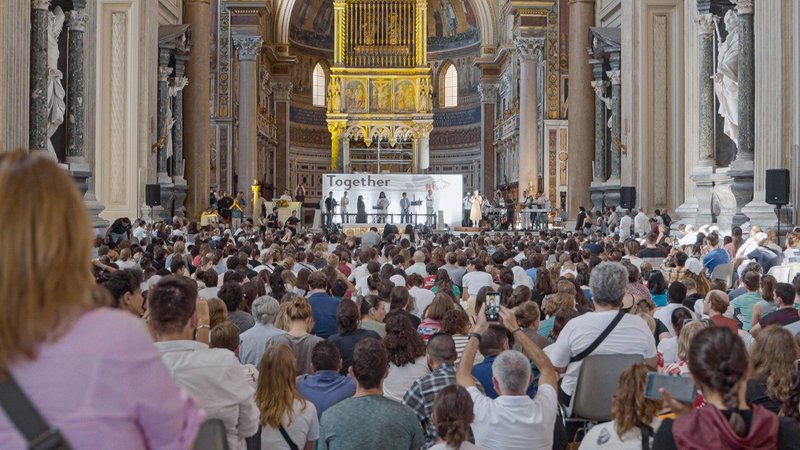Insieme (Together)
18 October 2023
18 October 2023
The Revd Dr Jonathan Hustler, Secretary of the Conference, reflects on his recent trip to Rome as part of the event, Together - Gathering of the People of God.
It was, as Annika pointed out, a sort of metaphor for the state of the Universal Church. We were walking through Rome, supposedly in a procession of around 3000 people, heading to the Vatican, but we were separated from the main party. Not only that, we were separated from some of our own, small, Methodist group. What had been designed as a symbol of the unity of the Church was not working out quite as we had hoped.

All this was part of ‘Together: The Gathering of the People of God’. Over the last two years, the Roman Catholic Church has been engaged in the Synodal process; the Pope has asked all catholic bishops to listen to their people on their hopes and expectations of the Church. The contributions from dioceses have been synthesized into national documents and the national contributions into continental documents. Now (October 2023) representative bishops and others have gathered in Rome to confer about the findings of the process and the future of the Church.
The Synod will include a number of ecumenical representatives (fraternal delegates), one of whom is the Revd Dr JC Park, the President of the World Methodist Council. The Pope has been clear that the leaders of the Roman Catholic Church are listening not only to their own people but to all Christian communions; the Synod, he has said, is not truly the Synod without those voices. In order to strengthen that part of the Synod’s work, the Taize Community organized a day of witness and reflection as the Synod members assembled, culminating in a Prayer Vigil in St Peter’s Square.
The Taize Community and the Pope were particularly keen that young adults should participate, and eight young Methodists accepted the invitation. After being in a number of different workshops, we gathered at St John Lateran (the Cathedral of Rome) for a service of Prayer and Praise, led by, among others, the Global Youth Rep. Elisha Asif. We were then to walk the five miles from the Lateran to the Vatican.

It was about a mile in that we took the wrong turn, as, in the crowds around the Colosseum, I mistakenly identified those ahead of us as part of the Gathering. Annika realised the error and took us back on course and got me thinking about how that did indeed reflect so much about the history of the Church.
How often do different groups of Christians, different Churches, set out for the same destination but become separated along the way? It is easy to become blasé about that, even to maintain that it has its advantages (as those or at least some of us who take a different route will be blessed in different ways), but the experience of that afternoon in Rome was a sense of being adrift from our brothers and sisters in Christ. My prayer, returning from Rome, is that we might feel that longing for togetherness that can impel us in our ecumenical endeavours.
We rejoined the main procession or at least some of us did. Three of the Methodist group made their own way (I suspect with others from the Gathering) via another route. The Methodist party didn’t reassemble until after the Prayer Vigil. I regret that one of the effects of that was to undermine a purpose of the day. So busy were Annika and I on the rest of the walk trying to reconnect the Methodists that we were barely able to engage in conversation with any of the fascinating groups of Christians from other denominations and other parts of the world who were walking alongside us.
How often do the divisions within our own churches impede our engagement with Christians of other traditions? Archbishop Justin Welby has often commented in recent months that what he terms ‘the internal ecumenism’ of the Anglican Communion has affected the Church of England’s engagement with wider ecumenical conversations and I find myself wondering if the energy that we have invested in learning to live with contradictory convictions has taken us away from broader expressions of unity. Surely, the opposite should be true: we who have managed at so many times in our history to accommodate different viewpoints and who have made inclusion one of our watchwords should be more open to embrace the difference of Christians of other traditions and recognise our commonality.
Ironically, the smaller Methodist group arrived at St Peter’s ahead of us and I realized that the mistake I had made was not only because I was following the wrong group but because I was following the route I had expected us to take (and therefore had not carefully checked the information).
How often in the course of Christian history has disunity been the fault of Church leaders who think they know what they are doing and take too little time or care to listen to others, or to the Holy Spirit? A key theme of the Synod is listening; in his homily at the prayer vigil the Pope spoke about the importance of silence. In a world of noise, he said, it is vital that Christians can be silent. Between the Gathering and the business of the Synod, Synod members were on retreat with the Pope, experiencing, the silence that would enable them later to hear the voice of the Holy Spirit in the voice of their fellows and the fraternal delegates.
The Vigil ended with a truly symbolic moment as the Pope led the church leaders present in blessing the congregation. Seeing a line of bishops and others pronouncing God’s blessing on the crowd gave me hope that, hard though it might be, the wounds of the Church can be healed. Part of the service had been an act of thanksgiving for the goodness of creation; it included a beautiful setting of the Canticle of St Francis and even those of us with little or no Italian could recognize the repeated assertion ‘Laudato Si’’ which is the title of Pope Francis’ encyclical on the climate crisis: hope for the healing of the Church gives hope for the healing of the environment. We were able to reaffirm our commitment to seek both.
The service included a song from Ukraine: hope for the healing of the Church gives hope for the healing of the nations (as Fred Kaan expressed it). I noticed that the mistake I had made on the walk was to pass by the wrong side of the Colosseum, the ruins of a place of the most hideous violence. There, each Good Friday, the Pope presides over the Stations of the Cross, reimagining Golgotha, a place of hideous violence. The conflict in Ukraine is not without a religious dimension; Bartholomew, the ecumenical patriarch, who was one of those blessing us, faces an even deeper separation from his brother in Moscow since the latter’s vocal support for Putin’s policy. A prayer for the unity of the Church which believes that the cycle of violence can be ended is a prayer for the peace of the world.
Over supper that night, Matthew (the director of the Methodist Ecumenical Office in Rome) reminded us that we are unlikely to see another event of that nature in our lifetime. Many of the divisions of Church have their roots in centuries past and the healing process will take time; it might be decades before anyone can properly assess the significance of that day in Rome. So we could continue down the wrong side of the Colosseum, assuming that in God’s providence all will be well in the end. Or we could, particularly as we look forward to the [whatever it is exactly we are doing with ‘God in Christ reconciling’], re-orientate ourselves and inject some urgency into the work of reunion, for the sake of ourselves, the Church of Christ, all the people of the world, and the whole of creation.